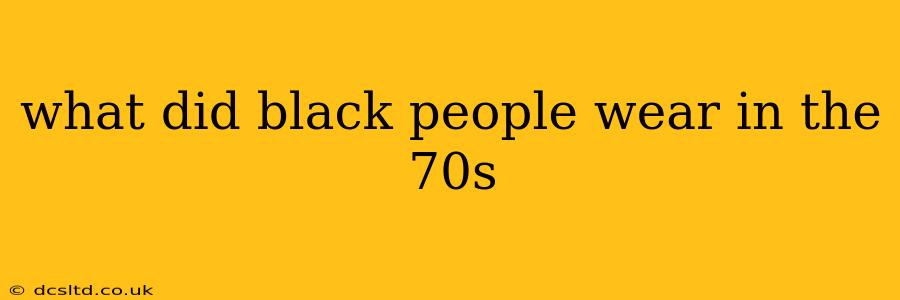What Did Black People Wear in the 70s? A Diverse Decade of Style
The 1970s were a period of significant social and political change, and this dynamism was reflected in the diverse and expressive fashion choices of Black Americans. It wasn't a monolithic style; instead, the decade showcased a vibrant tapestry of trends influenced by everything from African heritage to burgeoning disco culture and the rise of Afrocentricity. This wasn't simply "what Black people wore," but rather a complex interplay of personal expression, socio-economic factors, and geographical location.
The Power of Afrocentricity
The growing Black Power movement heavily influenced 70s fashion. This manifested in several ways:
- Dashiki and other African-inspired garments: Brightly colored, often intricately patterned dashikis (loose-fitting tunics) became a powerful symbol of cultural pride and identity. Other African-inspired fabrics and silhouettes, like boubou dresses and flowing skirts, also gained popularity.
- Natural hairstyles: The embrace of natural hairstyles like afros became a statement of self-acceptance and a rejection of Eurocentric beauty standards. This wasn't just a hairstyle; it was a political act.
Beyond Afrocentricity: Other Notable Trends
While Afrocentricity was a defining element, it wasn't the only trend. Black communities embraced a wide range of styles, including:
- Bell bottoms and platform shoes: These were ubiquitous across many communities in the 70s, reflecting the decade's overall fashion landscape. Black Americans incorporated these styles into their wardrobes, often adding their own unique flair.
- Disco style: The dazzling disco scene heavily impacted fashion. Sparkly fabrics, bold colors, and glamorous silhouettes became popular choices for both men and women, reflecting the era's energy and exuberance. Think shimmering fabrics, high-waisted pants, and jumpsuits.
- Streetwear influences: Hip-hop culture was emerging, and although it didn't fully explode until the 80s, its nascent influences were visible in some street styles. Think casual wear like jeans, t-shirts, and sneakers, often styled with bold accessories.
What were popular hairstyles for Black women in the 70s?
The 70s saw a remarkable shift in Black women's hairstyles, moving away from chemically straightened hair to celebrate natural textures. The afro was undoubtedly the most iconic hairstyle, a powerful symbol of Black pride and self-acceptance. Other popular styles included:
- Braids: Various braiding styles, including cornrows and individual braids, offered versatility and practicality.
- Afros with embellishments: Many women accessorized their afros with beads, scarves, or decorative combs.
- Long, flowing styles (achieved naturally or with extensions): While embracing natural hair was prevalent, some women also opted for longer styles, sometimes achieved with extensions or weaving techniques.
What kind of clothes did Black men wear in the 70s?
Black men's fashion in the 70s was equally diverse, reflecting individual styles and cultural influences. Popular choices included:
- Dashikis and other African-inspired garments: Similar to women, men adopted dashikis as a powerful statement of cultural identity.
- Suits and sharp tailoring: Sharp suits and tailored clothing were worn for formal occasions and professional settings.
- Jeans and casual wear: Casual styles like jeans, t-shirts, and sportswear were common for everyday wear.
- Wide-leg pants and platform shoes: Men also embraced the bell-bottom trend, often paired with platform shoes, reflecting the wider fashion trends of the decade.
How did socioeconomic status affect clothing choices in the 1970s for Black people?
Socioeconomic status, as in any era, played a role in clothing choices. Individuals with greater financial resources could afford more luxurious fabrics, designer labels, and tailored garments. However, even within limitations, creativity and self-expression flourished. Resourcefulness was key, with many individuals making their own clothes, adapting existing garments, or shopping secondhand.
The 1970s were a period of remarkable fashion diversity within the Black community. It wasn't a single, uniform style but rather a vibrant expression of cultural pride, personal style, and the socio-political climate of the time. Understanding the 70s Black fashion landscape requires appreciating the nuances and the many contributing factors that shaped the clothing choices of the era.
